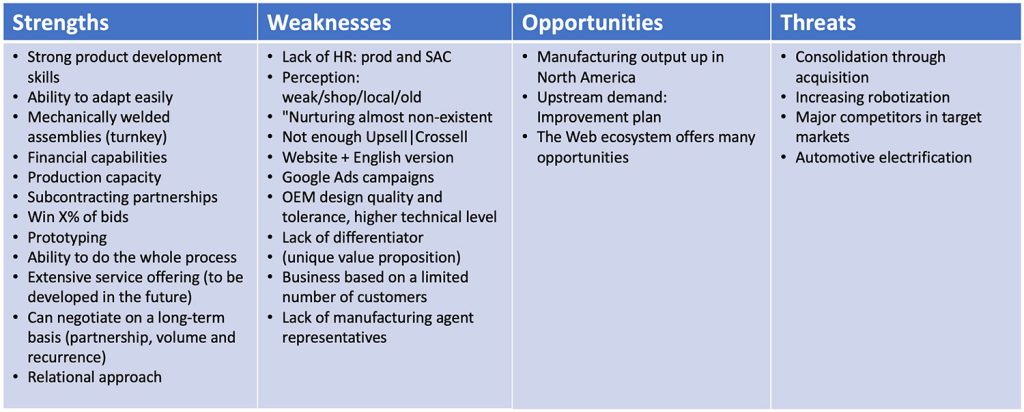
For both us and our customers, strategic planning in marketing is a demanding, methodical but oh-so-essential process. It requires deep thought, meticulous analysis and the ability to project your business into the future.
In the world of B2B marketing, every decision must be carefully calculated. Building a robust strategic marketing plan is crucial to guiding these decisions. At ExoB2B, we have consolidated our approach by developing analysis grids inspired by the methodologies of Pierre Filiatrault and David Aaker, which I consider to be “our father and mother bibles” of strategic planning, so complementary are they.
See picture below. 😏

Here’s an overview of the key stages we focus on:
1- B2B strategic marketing analysis
Before you can chart a course, you need to know where you are. That’s why every good strategic marketing plan starts with an internal environment analysis, focusing on the elements that concern the company and its Web and digital ecosystem. As for the analysis of the external environment, this encompasses the study of market trends, competitive intelligence and an understanding of evolving customer needs. This step is the foundation of any strategic plan, as it provides a global vision of the playing field.
A mandate for marketing analysis (diagnosis) with recommendations in B2B strategic marketing covers both digital and traditional marketing. It involves an in-depth analysis of the internal and external marketing strategies and activities of a company that sells its products or services to other companies.
The main objective is to determine the company’s B2B marketing performance and identify opportunities for improvement. The audit needs to be carried out with a great deal of rigor and different expertise, integrating marketing and sales knowledge and skills to ensure good alignment between the two functions. This is B2B after all!
This also involves a thorough SWOT analysis, assessing strengths, weaknesses, opportunities and threats. Understanding your current market position is essential to defining your trajectory.
Example of SWOT: (Note. To protect our client’s anonymity, I have removed several details, as I will do for the next examples).

2- Determining issues and objectives
A first step completed… We’re in a position to understand the factors that define the most important issues facing your company, and to guide your marketing in a strategic direction. And we do this in the most informed way possible, so you can make the best decisions. With good strategic planning, your company’s growth is better planned, more secure.
Example of issues:
1- Harnessing cutting-edge technologies for commercialization
2- Enhancing product development with innovative partners
3- Strengthening brand image
4– Being less dependent on a few customers
5- Market differentiation
6- Penetrate target market quickly and efficiently
7- Find strategic partners to facilitate entry into new markets
8- Increase Web ecosystem performance to create a first-mover advantage and positively influence demand generation.
Every action, every decision must be justified by a precise objective. Increasing brand awareness, conquering new segments, retaining existing customers… These objectives must be SMART: Specific, Measurable, Achievable, Realistic and Time-bound. Otherwise, they will be difficult to measure.
Example :
Increase sales from $20 to $25 million over the next 18 months to XXX in territory XXX.
3. Planification stratégique : les stratégies fondamentales
“Our B2B marketing strategies are innovative and winning. They align with your customers and stand out from those of your competitors. Their deployment creates lasting value for our customers. The ExoB2B people responsible for analysis and strategy are recognized experts in their fields, and work in co-creation with our customers.”
The customer is the central pillar. Understanding the customer’s needs and expectations is the key to developing one or more strategies that are both fundamental and tailor-made for the customer.
What are these fundamental strategies? They can be subdivided into three strategies: supply, demand and competition. The first two, which we are interested in, can be further subdivided as follows:
- Supply strategies
- Portfolio
- Growth
- Demand strategies
- Segmentation
- Positioning
- Competitive differentiation
In the face of ever-increasing competition, differentiation is crucial. Hence the third or competitive strategy, which is subdivided into two. We then talk about competitive analysis and types of competitive strategy.
4. Strategic recommendations
In the next phase, we make recommendations to our customer. This goes without saying. First of all, they will be strategic and will concern, for example :
A- Brand strategy: build a brand strategy based on your strengths and strategic positioning, and develop a strategic signature.
B- Competitive positioning: define your place in your strategic field of activity. To do this, prioritize one of three key areas: customer relations, price and performance.
C- Customer journey: draw up a detailed customer journey, identifying key contact points and key moments for targeted personas within target markets.
D- Content strategy: design a strategy that includes an SEO strategy specific to the home market and the target market.
E- Web ecosystem: leverage the rapid creation of a high-performance web ecosystem, including website redesign, to position yourself as a leader and leverage first-mover advantage in your target market.
F- Value proposition: develop a unique value proposition that will set you apart from the competition, facilitate communication and attract the right customers by market seg,ent.
G- Market segmentation: segment your market to refine your targeting and better meet the specific needs of each segment.
H- Market research: to choose a strategic positioning for your company.
5. Tactic recommandations
In a strategic B2B marketing action plan, tactical recommendations are specific actions you will take to implement your overall strategy. These tactics are designed to achieve your B2B marketing objectives in a practical and measurable way. Here are some examples of tactical recommendations you could include in your strategic action plan:
- Content marketing campaigns: create a detailed editorial calendar for the regular publication of blog posts. Also white papers, videos, webinars and other content relevant to your B2B audience.
- Website optimization: improve the usability and relevance of your website for B2B visitors. Implement improvements to user experience (UX), search engine optimization (SEO) and navigation.
- Social networks and media strategy: develop a social media strategy to promote your content, interact with your audience and build relationships with B2B influencers.
- Online advertising: use paid advertising on platforms such as Google Ads and LinkedIn Ads to target specific B2B prospects and generate qualified leads.
- Email marketing: create targeted email marketing campaigns to nurture relationships with existing customers and educate prospects about your products or services.
- Thought Leadership: establish a solid thought leadership program to position yourself as a leader in your field of expertise.
Thought leadership can help you establish your company as an authority in your field, attract qualified prospects and build trust with your existing customers. This tactic takes time and consistency, but it can provide significant long-term benefits for your B2B business.
6. Action plan
The process of creating an action plan is often collaborative. It involves working closely with the customer to understand their needs, human and financial resources, and constraints. This collaboration ensures that the action plan is aligned with the customer’s objectives.
- Choosing communication channels: a crucial part of planning is determining which communication channels to use to reach the target audience. This can include online channels such as social media and networks, e-mail marketing, websites, as well as offline channels such as events, trade shows, trade publications, etc.
- Developing campaigns or special events: depending on the objectives and channels chosen, it may be necessary to develop advertising campaigns or special events. These activities are designed to attract the attention of the target audience and promote the company’s products or services.
- Budgets and resources: an action plan must include a budget allocation for each planned activity. This involves determining how much money will be allocated to each channel, campaign or event. It is also important to manage the human and material resources needed to implement the plan.
- Timetable: to ensure effective execution, an action plan must also include a clear timeline or timelines, indicating when each activity is to be completed.
- Monitoring and adjustment: once the action plan is underway, it is essential to track progress and monitor results. If necessary, adjustments can be made to optimize performance.
The B2B marketing action plan is the bridge between initial strategy and practical implementation. It guides you through all the steps required to achieve your business objectives.
7. The critical evaluation stage
This last step is often overlooked! We can’t stress enough how important it is to successful strategic marketing or other planning. A marketing plan is never set in stone; it’s dynamic, adaptable. Evaluation, taking feedback into account, plays a crucial role in your B2B strategic marketing plan for several important reasons:
- Measuring objectives and results: evaluation measures the extent to which you have achieved your B2B marketing objectives. It helps you determine whether your efforts have generated the desired results. Efforts such as increasing sales, acquiring new customers or retaining existing ones.
- Strategy optimization: regular evaluation enables you to identify what’s working and what’s not in your B2B marketing plan. This allows you to adjust your strategy based on actual data rather than assumptions, maximizing your effectiveness.
- Resource allocation: the same assessment helps you to allocate your resources (budget, staff, time) wisely by identifying the most effective channels and initiatives. This minimizes waste and enables you to focus your investments on the most profitable activities.
- Reactivity to change: the B2B market is often subject to rapid change. Constant assessment allows you to detect emerging trends, new opportunities or potential threats, enabling you to react quickly to stay competitive. Evaluation helps improve the profitability of your B2B marketing efforts. This can mean lower customer acquisition costs and higher return on investment (ROI).
- Strengthening strategic planning: evaluation feeds into long-term strategic planning by providing information on long-term trends, opportunities to exploit and challenges to anticipate.
Strategic planning : conclusion
In short, a strategic B2B marketing plan is essential to maximize your effectiveness, make informed decisions, adapt to market needs and maintain your competitiveness. Its evaluation helps optimize resources and ensure that marketing makes a significant contribution to overall company objectives.
Want to know more about strategic planning and your next B2B marketing strategy? Contact our experts. We’re here to help you achieve your strategic B2B marketing objectives.






